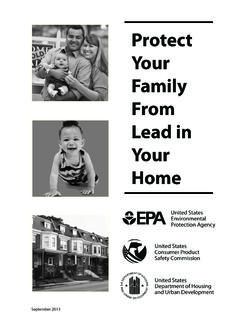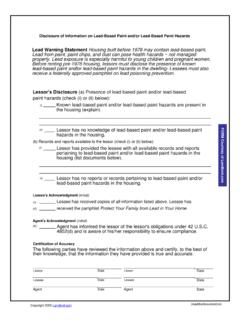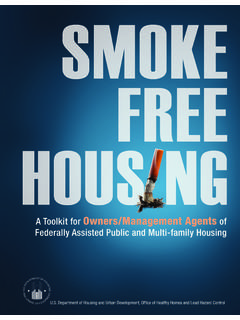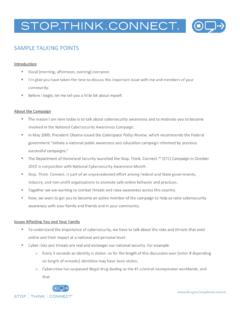Transcription of How to Plan for Workplace Emergencies and …
1 How to Plan forWorkplace Emergenciesand Department of LaborOccupational Safety and Health AdministrationOSHA 30882001 (Revised)This booklet provides a generic overview of a standards-related topic. This publication does not alter or determinecompliance responsibilities, which are described in theOSHA standards and the Occupational Safety andHealth Act. Because interpretations and enforcementpolicy may change over time, the best sources foradditional guidance on OSHA compliance requirementsare current administrative interpretations and decisionsby the Occupational Safety and Health ReviewCommission and the courts. This publication is in thepublic domain and may be reproduced fully or partiallywithout permission. Source credit is requested but will make this information available to sensoryimpaired individuals upon request. Call (202) to Plan forWorkplace Emergenciesand Department of LaborElaine L.
2 Chao, SecretaryJohn L. Henshaw, Assistant SecretaryOccupational Safety and Health AdministrationOSHA 30882001 (Revised) 1 What is a Workplace emergency? .. 1 How do you protect yourself, your employees, and your business? .. 1 What is an emergency action plan? .. 1 What should your emergency action plan include? .. 2 How do you alert employees to an emergency? .. 3 How do you develop an evacuation policy and procedures? .. 3 Under what conditions should you call for an evacuation? .. 4 What is the role of coordinators and evacuation wardens during an emergency? .. 4 How do you establish evacuation routes and exits?.. 5 How do you account for employees after an evacuation?.. 5 How should you plan for rescue operations? .. 6 What medical assistance should you provide during an emergency?.. 6 What role should employees play in your emergency action plan? .. 6 What employee information should your plan include?
3 7 What type of training do your employees need?.. 7 How often do you need to train your employees?.. 8 What does your plan need to include about hazardous substances?.. 8 What special equipment should you provide for Emergencies ?.. 9 How do you choose appropriate respirators and other equipment? .. 9 Who should you coordinate with when drafting your emergency action plan? .. 9 What are OSHA s requirements for Emergencies ?.. 10 What other OSHA standards address emergency planning requirements?.. 11 What assistance does OSHA provide?.. 12 What education and training does OSHA offer?.. 12 What other publications does OSHA offer?.. 13 What electronic services does OSHA provide? .. 13 What free onsite consultation does OSHA provide?.. 14 What are the Voluntary Protection Programs?.. 14 What partnership opportunities does OSHA provide?.. 15 What is the value of a good safety and health program?
4 15 What is the role of state programs? .. 15 What other groups or associations can help me? .. 15 Appendices:1. OSHA Regional and Area Office Directory .. 172. OSHA-Approved Safety and Health 203. OSHA Consultation Offices .. 20 ContentsPagev1 Nobody expects an emergency or disaster especially one thataffects them, their employees, and their business the simple truth is that Emergencies and disasters can strikeanyone, anytime, and anywhere. You and your employees couldbe forced to evacuate your company when you least expect booklet is designed to help you, the employer, plan for thatpossibility. The best way to protect yourself, your workers, and yourbusiness is to expect the unexpected and develop a well-thought-out emergency action plan to guide you when immediate action emergency is an unforeseen situation that threatensyour employees, customers, or the public; disrupts or shutsdown your operations; or causes physical or environmental may be natural or manmade and include the following: Floods, Hurricanes, Tornadoes, Fires, Toxic gas releases, Chemical spills, Radiological accidents, Explosions, Civil disturbances, and Workplace violence resulting in bodily harm and best way is to prepare to respond to an emergency beforeit happens.
5 Few people can think clearly and logically in a crisis,so it is important to do so in advance, when you have time to the worst-case scenarios. Ask yourself what you woulddo if the worst happened. What if a fire broke out in your boilerroom? Or a hurricane hit your building head-on? Or a train carryinghazardous waste derailed while passing your loading dock? Onceyou have identified potential Emergencies , consider how they wouldaffect you and your workers and how you would emergency action plan covers designated actions employersand employees must take to ensure employee safety from fireand other Emergencies . Not all employers are required to establishan emergency action plan. See the flowchart on page 11 todetermine if you are. Even if you are not specifically required to doso, compiling an emergency action plan is a good way to protectyourself, your employees, and your business during an together a comprehensive emergency action plan that dealswith all types of issues specific to your worksite is not is aworkplaceemergency?
6 How do youprotect yourself, your employees,and yourbusiness?What is anemergency actionplan?2 You may find it beneficial to include your management team andemployees in the process. Explain your goal of protecting lives andproperty in the event of an emergency, and ask for their help inestablishing and implementing your emergency action plan. Theircommitment and support are critical to the plan s developing your emergency action plan, it s a good ideato look at a wide variety of potential Emergencies that couldoccur in your Workplace . It should be tailored to your worksite andinclude information about all potential sources of an emergency action plan means you should do a hazardassessment to determine what, if any, physical or chemical hazards inyour workplaces could cause an emergency. If you have more thanone worksite, each site should have an emergency action a minimum, your emergency action plan must include thefollowing: A preferred method for reporting fires and other Emergencies ; An evacuation policy and procedure; Emergency escape procedures and route assignments, such as floorplans, Workplace maps, and safe or refuge areas;What shouldyour emergencyaction planinclude?
7 Names, titles, departments, and telephone numbers of individualsboth within and outside your company to contact for additionalinformation or explanation of duties and responsibilities under theemergency plan; Procedures for employees who remain to perform or shut downcritical plant operations, operate fire extinguishers, or performother essential services that cannot be shut down for everyemergency alarm before evacuating; and Rescue and medical duties for any workers designated to also may want to consider designating an assembly locationand procedures to account for all employees after an addition, although they are not specifically required by OSHA,you may find it helpful to include in your plan the following: The site of an alternative communications center to be used in theevent of a fire or explosion; and A secure on- or offsite location to store originals or duplicatecopies of accounting records, legal documents, your employees emergency contact lists, and other essential plan must include a way to alert employees, includingdisabled workers, to evacuate or take other action, and how toreport Emergencies , as required.
8 Among the steps you must takeare the following: Make sure alarms are distinctive and recognized by all employeesas a signal to evacuate the work area or perform actions identifiedin your plan; Make available an emergency communications system such as apublic address system, portable radio unit, or other means tonotifyemployees of the emergency and to contact local lawenforcement, the fire department, and others; and Stipulate that alarms must be able to be heard, seen, or otherwiseperceived by everyone in the Workplace . You might want toconsider providing an auxiliary power supply in the event thatelectricity is shut off. (29 CFR (b)(2) offers moreinformation on alarms.)Although it is not specifically required by OSHA, you also maywant to consider the following: Using tactile devices to alert employees who would not otherwisebe able to recognize an audible or visual alarm; and Providing an updated list of key personnel such as the plantmanager or physician, in order of priority, to notify in the event ofan emergency during off-duty disorganized evacuation can result in confusion, injury, andproperty damage.
9 That is why when developing youremergency action plan it is important to determine the following: Conditions under which an evacuation would be necessary; A clear chain of command and designation of the person in yourbusiness authorized to order an evacuation or shutdown. You maywant to designate an evacuation warden to assist others in anevacuation and to account for personnel; Specific evacuation procedures, including routes and exits. Postthese procedures where they are easily accessible to allemployees; Procedures for assisting people with disabilities or who do notspeak English; Designation of what, if any, employees will continue or shut downcritical operations during an evacuation. These people must beHow do youdevelop anevacuation policyand procedures?How do youalert employeesto anemergency?4capable of recognizing when to abandon the operation andevacuate themselves; and A system for accounting for personnel following an employees transportation needs for the event of an emergency, local emergency officials may orderyou to evacuate your premises.
10 In some cases, they may instructyou to shut off the water, gas, and electricity. If you have access toradio or television, listen to newscasts to keep informed and followwhatever official orders you other cases, a designatedperson within your businessshould be responsible for makingthe decision to evacuate or shutdown operations. Protecting thehealth and safety of everyone inthe facility should be the firstpriority. In the event of a fire, animmediate evacuation to apredetermined area away fromthe facility is the best way toprotect employees. On the otherhand, evacuating employees maynot be the best response to anemergency such as a toxic gasrelease at a facility across townfrom your type of building you work in may be a factor in your buildings are vulnerable to the effects of disasters such astornadoes, earthquakes, floods, or explosions. The extent of thedamage depends on the type of emergency and the building sconstruction.

















